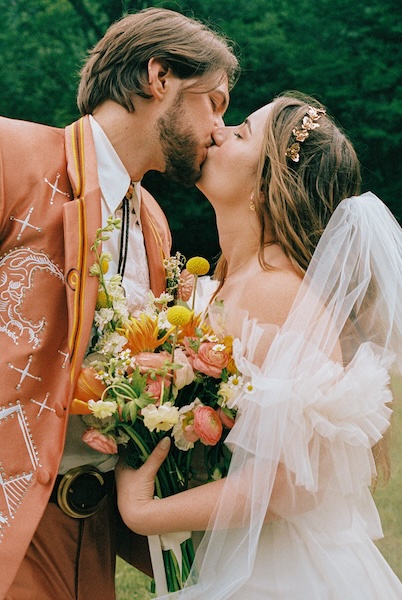Sasha Rudensky: Photographing Post-Soviet Culture
January 30, 2014
“[Brightness] is a kind of synonym for being beautiful, unforgettable—something that leaves a mark. It’s been a cultural pursuit for a long time,” says the Russian-born photographer who splits her time between New Haven, Connecticut, and Brooklyn, New York. But in post-Soviet culture, this idea manifests itself as “a distinct brand of affectation, depravity, garishness and melancholy,” Rudensky says in her project statement.
The images in the series “Brightness” (formerly called “Novij Mir”), like the term for which they are titled, leave an indelible impression upon the viewer. In seemingly mundane scenes—in the bedroom, at the theater, on the street—Rudensky’s subjects (an “orphan generation of Russians, Ukrainians and Belarusians”) are shown going about everyday activities in their environment. The scenes, which she says are “somewhat documentary and partly staged for the purpose of creating a narrative,” are rich with a historical underpinning of a people who’ve had to adapt to major political change.
 “Emerald Fountain, 2009.”
“Emerald Fountain, 2009.”
Fall of USSR, A New Identity
The region is still redefining itself after the fall of Soviet rule, a notion Rudensky initially became interested in documenting when she received a traveling fellowship through Brandeis University, which funded her work for an entire year. The resulting series, “Remains,” “was very much about a reckoning with the past…and looking at an end of an era,” she says. “I like my pictures to have one foot in reality and one foot in a fictional space.”
And her second post-Soviet series, “Brightness,” she says, “is a response to the ideological vacuum that has appeared in this place,” Rudensky says. The Soviet Union, she explains, “was once an ideologically driven space, but it was erased and there wasn’t anything offered in its place. A consumer-driven culture is what has taken the place of the [Soviet] ideology.”
This affinity for material opulence (as exemplified in architectural ornamentation and rich fabrics) can be seen as far back as the Russian Orthodoxy and the Russian tsarist era, she explains. “The Soviet Union did a good job of pushing that [desire] down…but it has come back to the top in the aftermath [of the Soviet dissolution],” she says. “I see it as a craving for excess—in all aspects of culture.” In her images, the theme of material superficiality persists—in the act of dressing (and undressing), in decorative interiors and in the types of activities her subjects engage in.
 “Dressing, 2009.”
“Dressing, 2009.”
Rudensky left Moscow (when it was still part of the Soviet Union) for the U.S. with her family at ten years old—living first in New Haven, Connecticut, and then spending her childhood in Seattle, Washington. She returned to the East Coast for undergrad at Wesleyan University (where she currently teaches), and later, an MFA in photography at Yale University­—the location of her formal photography education.
Though she first discovered photography in high school under the auspices of her boyfriend at the time, she didn’t take her work seriously until the age of 25 when she made “Remains.” Rudensky says the photographic medium “made sense to me from the beginning. To me it felt like a language. It was a way to express myself, whereas it was difficult [to do so] in other forms.”
 “Hannibal Lector, 2010”
“Hannibal Lector, 2010”
“Brightness” as Subject
The “brightness” in Rudensky’s work has a literal connotation too: Integral to her images is the luminous quality of natural light, an element she considers just as important as her human subjects and the environment in which they are staged. “To me the light is the activating agent, it’s a kind of character in its own right,” she says. “Color and light feel inseparable to me.”
She describes the emotional content and esthetic quality of her images as “elegiac” in their repose. “It’s a fabricated world I am creating,” she says. The process between herself and her subject, she explains, is very interactive. She uses “prompts” for the shoot until something interesting happens and a character emerges. “I see the character as a kind of cultural phenomenon…people are products of culture, so to speak,” she says. “I wouldn’t really separate the two [subject and environment].”
 “Splitting, 2011.”
“Splitting, 2011.”
Revisiting One’s Roots
Rather than thinking of her work as a social critique, Rudensky prefers to consider it a personal response to a culture. “I see it as a twisted mirror on myself and my experience. I both recognize what I see and I find it really strange—and that’s where exciting pictures happen,” she says.
She says the ethnicity of her Eurasian subjects is often ambiguous to those who view her work. She says this region has so many cultural influences, and the people are a reflection of this—“it’s a kind of ‘imitation of life syndrome,’ which I find very fascinating,” she says.
But Rudensky doesn’t allow herself to fully reintegrate into the culture she documents. “I immerse myself in a place, but when you’re a photographer you never fully immerse yourself because it’s important to have that outside perspective and be able to look at what it is you’re observing from the outside,” she says.
 “Boxers, 2011”
“Boxers, 2011”
Next up for the photographer: Rudensky plans to concentrate locally on a new project, based on images from the U.S. News & World Report archive housed in the Library of Congress.




